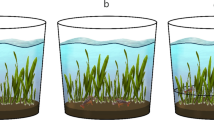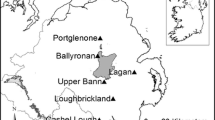Abstract
The Chinese mitten crab (Eriocheir sinensis) is a damaging invader which is designated as a species of Union Concern within the European Union. A negative impact of the crabs on macrophyte vegetation in lowland rivers is suspected but not yet proven or quantified. We have performed a mesocosm study that combines a density gradient of Chinese mitten crabs (0, 0.3, 1.0 and 2.5 ind. m−2) with chemical stress (2350 µg EDTA L−1 + 258 µg glyphosate L−1) or light limitation stress (− 70% irradiance compared to control) on water plants (Myriophyllum spicatum). The results clearly demonstrate that the crabs are capable of removing plant shoots effectively which can lead to a complete elimination of the vegetation. Generally, the higher the crab density, the sooner the plants started to disappear and the sooner the vegetation was completely removed. Additional light and chemical stress accelerated this process: plant disappearance at a crab density of 0.3 ind. m−2 compared to 1.0 ind. m−2 in the control treatments. Video recording, plant strength and crab pinch strength measurements and stable isotope signatures of δ13C and δ15N in the Chinese mitten crabs and their possible food sources showed that directly eating the plants is causing only minor damage to the plants. Most damage comes from the movement of the crabs and crab–crab interactions during which they use their chelae to grasp the shoots. We conclude that a decline of vegetation as a consequence of Chinese mitten crab behaviour can be a realistic scenario in freshwater ecosystems and warrants close attention and monitoring. Being primary producers and ecological engineers, macrophytes are key species in these ecosystems, whose services are lost when they disappear and are difficult to restore.






Similar content being viewed by others
References
Ang KY, Lucas PW, Tan HTW (2008) Novel way of measuring the fracture toughness of leaves and other thin films using a single inclined razor blade. New Phytol 177:830–837
Barko JW, Smart RM (1981) Comparative influences of light and temperature on the growth and metabolism of selected submersed freshwater macrophytes. Ecol Monogr 51(2):219–235
Boerema A, Schoelynck J, Bal K, Vrebos D, Jacobs S, Staes J, Meire P (2014) Economic valuation of ecosystem services, a case study for aquatic vegetation removal in the Nete Catchment, Belgium. Ecosyst Serv 7:46–56
Bouma S, Soes DM (2010) A risk analysis of the Chinese mitten crab in The Netherlands. Eindrapportage Bureau Waardenburg, Culemborg, p 52
Carpenter SR, Lodge DM (1986) Effects of submerged macrophytes on ecosystem processes. Aquat Bot 26:341–370
Czerniejewski P, Rybczyk A, Wawrzyniaki W (2010) Diet of the Chinese mitten crab, Eriocheir sinensis H. Milne Edwards, 1853, and potential effects of the crab on the aquatic community in the River Odra/Oder estuary (N.-W. Poland). Crustaceana 83(2):195–205
Dill GM (2005) Glyphosate-resistant crops: history, status and future. Pest Manag Sci 61(3):219–224
Elser JJ, Fagan WF, Denno RF, Dobberfuhl DR, Folarin A, Huberty A, Interlandi S, Kilham SS, McCauley E, Schulz KL, Siemann EH, Sterner RW (2000) Nutritional constraints in terrestrial and freshwater food webs. Nature 408(6812):578–580
EU Regulation No 1143/2014 of the European Parliament and of the Council of 22 October 2014 on the prevention and management of the introduction and spread of invasive alien species. OJ L 317, 4.11.2014, pp 35–55
European Environmental Agency (2012) The impacts of invasive alien species in Europe. Technical report No 16/2012. 114 pp. https://doi.org/10.2800/65864
Garcia-de-Lomas J, Dana ED, López-Santiago J, González R, Ceballos G, Ortega F (2010) Management of the Chinese mitten crab, Eriocheir sinensis (H. Milne Edwards, 1853) in the Guadalquivir Estuary (Southern Spain). Aquat Invasions 5(3):323–330
Gilbey V, Attrill MJ, Coleman RA (2008) Juvenile Chinese mitten crabs (Eriocheir sinensis) in the Thames estuary: distribution, movement and possible interactions with the native crab Carcinus maenas. Biol Invasions 10:67–77
Gross EM, Bakker ES (2012) The role of plant secondary metabolites in freshwater macrophyte–herbivore interactions: limited or unexplored chemical defences? In: Iason GR, Dicke M, Hartley SE (eds) The ecology of plant secondary metabolites: from genes to global processes. Cambridge University Press, British Ecological Society, Cambridge, pp 154–169
Hangarter RP, Stasinopoulos TC (1991) Effect of Fe-catalyzed photo oxidation of EDTA on root growth in plant culture media. Plant Physiol 96:843–847
Herborg L-M, Rushton SP, Clare AS, Bentley MG (2003) Spread of the Chinese mitten crab (Eriocheir sinensis, H. Milne Edwards) in continental Europe. Hydrobiologia 503:21–28
Herborg L-M, Rushton SP, Clare AS, Bentley MG (2005) The invasion of the Chinese mitten crab (Eriocheir sinensis) in the United Kingdom and its comparison to continental Europe. Biol Invasions 7:959–968
Herborg L-M, Rudnick DA, Siliang Y, Lodge DM, MacIsaac HJ (2007) Predicting the range of Chinese mitten crabs in Europe. Conserv Biol 21(5):1316–1323
Hidding B, Bakker ES, Hootsmans MJM, Hilt S (2016) Synergy between shading and herbivory triggers macrophyte loss and regime shifts in aquatic systems. Oikos 125:1489–1495
Jacob U, Mintenbeck K, Brey T, Knust R, Beyer K (2005) Stable isotope food web studies: a case for standardized sample treatment. Mar Ecol Prog Ser 287:251–253
Jin G, Xie P, Li ZJ, Kuwabara R (2001a) Food habits and feeding rhythm of the early juvenile Chinese mitten crab (Eriocheir sinensis) in experimental tanks. J Freshw Ecol 16(4):647–648
Jin G, Xie P, Li Z (2001b) Effects of the stocking density and body size of the mitten Crab (Eriocheir sinensis) on aquatic plant biomass. J Freshw Ecol 16(3):341–345
Jin G, Xie P, Li ZJ (2003) Food habits of two-year-old Chinese mitten crab (Eriocheir sinensis) stocked in Lake Bao’an, China. J Freshw Ecol 18(3):369–375
Kristensen DK, Kristensen E, Mangion P (2010) Food partitioning of leaf-eating mangrove crabs (Sesarminae): experimental and stable isotope (13C and 15N) evidence. Estuar Coast Shelf S 87:583–590
Lodge DM, Kershner MW, Aloi JE, Covich AP (1994) Effects of an omnivorous crayfish (Orconectes rusticus) on a freshwater littoral food web. Ecology 75(5):1265–1281
Lorrain A, Paulet YM, Chauvaud L, Savoye N, Donval A, Saout C (2002) Differential delta C-13 and delta N-15 signatures among scallop tissues: implications for ecology and physiology. J Exp Mar Biol Ecol 275:47–61
Mao Z, Gu X, Zeng Q (2016) Food sources and trophic relationships of three decapod crustaceans: insights from gut contents and stable isotope analyses. Aquac Res 47:2888–2898
McCutchan JH, Lewis WM, Kendall C, McGrath CC (2003) Variation in trophic shift for stable isotope ratios of carbon, nitrogen, and sulfur. Oikos 102:378–390
Normant M, Wiszniewska A, Szaniawska A (2000) The Chinese mitten crab Eriocheir sinensis (Decapoda: Grapsidae) from Polish waters. Oceanologia 42(3):375–383
O’Hare MT, Aguiar FC, Asaeda T, Bakker ES, Chambers PA, Clayton JS, Elger A, Ferreira TM, Gross EM, Gunn IDM, Gurnell AM, Hellsten S, Hofstra DE, Li W, Mohr S, Puijalon S, Szoszkiewicz K, Willby NJ, Wood KA (2018) Plants in aquatic ecosystems: current trends and future directions. Hydrobiologia 812:1–11
Ojaveer H, Gollasch S, Jaanus A, Kotta J, Laine AO, Minde A, Normant M, Panov VE (2007) Chinese mitten crab Eriocheir sinensis in the Baltic Sea—a supply-side invader? Biol Invasions 9:409–418
Parnell A, Jackson A (2013) Stable Isotope Analysis in R. vol 4.2. R Foundation for statistical computing: Vienna
Parnell AC, Inger R, Bearhop S, Jackson AL (2010) Source partitioning using stable isotopes: coping with too much variation. PLoS ONE 5(3):e9672
Phillips DL, Koch PL (2002) Incorporating concentration dependence in stable isotope mixing models. Oecologia 130:114–125
R Development Core Team (2016) R: a language and environment for statistical computing. vol 3.3.2. R Foundation for Statistical Computing: Vienna
Reddy KN, Rimando AM, Duke SO (2004) Aminomethylphosphonic acid, a metabolite of glyphosate, causes injury in glyphosate-treated. Glyphosate-resistant soybean. J Agr Food Chem 52(16):5139–5143
Reitsema RE, Meire P, Schoelynck J (2018) The future of freshwater macrophytes in a changing world: dissolved organic carbon quantity and quality and its interactions with macrophytes. Front Plant Sci 9:629
Rogers L (2000) The feeding ecology of the invasive Chinese mitten crab, Eriocheir sinensis: implications for California’s freshwater communities. Senior Research Seminar, Environmental Science Group Major. University of California at Berkeley, Berkeley
Rosewarne PJ, Mortimer RJG, Newton RJ, Grocock C, Wing CD, Dunn AM (2016) Feeding behaviour, predatory functional responses and trophic interactions of the invasive Chinese mitten crab (Eriocheir sinensis) and signal crayfish (Pacifastacus leniusculus). Freshw Biol 61:426–443
Rudnick DA, Chan V, Resh VH (2005) Morphology and impacts of the burrows of the Chinese mitten crab, Eriocheir sinensis, in South San Francisco Bay, California, U.S.A. Crustaceana 78(7):787–807
Sand-Jensen K, Jeppesen E, Nielsen K, Vanderbijl L, Hjermind L, Nielsen LW, Iversen TM (1989) Growth of macrophytes and ecosystem consequences in a lowland Danish stream. Freshw Biol 22:15–32
Schoelynck J, De Groote T, Bal K, Vandenbruwaene W, Meire P, Temmerman S (2012) Self-organised patchiness and scale-dependend biogeomorphic feedbacks in aquatic river vegetation. Ecography 35(8):760–768
Short FT, Kosten S, Morgan PA, Malone S, Moore GE (2016) Impacts of climate change on submerged and emergent wetland plants. Aquat Bot 135:3–17
Thongtham N, Kristensen E (2005) Carbon and nitrogen balance of leaf-eating sesarmid crabs (Neoepisesarma versicolor) offered different food sources. Estuar Coas Shelf S 65:213–222
Van der Wal JEM, Dorenbosch M, Immers AK, Forteza CV, Geurts JJM, Peeters ETHM, Kroese B, Bakker ES (2013) Invasive crayfish threaten the development of submerged macrophytes in lake restoration. PLoS ONE 8(10):e78579
Van Vliet MTH, Franssen WHP, Yearsley JR, Ludwig F, Haddeland I, Lettenmaier DP, Kabat P (2013) Global river discharge and water temperature under climate change. Global Environ Chang 23(2):450–464
VMM Vlaamse Milieu Maatschappij (2015) Macrofyten in de Grote Nete. Eerste tussentijds rapport. D/2015/6871/051. 39 pp (in Dutch)
VMM Vlaamse Milieu Maatschappij 2017. Macrofyten in de Grote Nete. Tweede tussentijds rapport. D/2017/6871/042. 45 pp (in Dutch)
Walinga I, Van Vark W, Houba VJG, Van Der Lee JJ (1989) Plant analysis procedures. Soil and Plant Analysis, Part 7, Wageningen, NL
Wang H, Xu C, Wang H, Kosten S (2017) Long-term density dependent effects of the Chinese mitten crab (Eriocheir sinensis (H. Milne Edwards, 1854)) on submersed macrophytes. Aquat Bot 140:84–91
Wójcik D, Normant M, Dmochowska B, Fowler A (2015) Impact of Chinese mitten crab Eriocheir sinensis on blue mussel Mytilus edulis trossulus - Laboratory studies of claw strength, handling behavior, consumption rate, and size selective predation. Oceanologia 57(3):263–270
Wójcik-Fudalewska D, Normant-Saremba M (2016) Long-term studies on sex and size structures of the non-native crab Eriocheir sinensis from Polish coastal waters. Mar Biol Res 12(4):412–418
Eindrapportage Bureau Waardenburg, Culemborg, The Netherlands. 52 pp
Zefferman EP (2004) Increasing canopy shading reduces growth but not establishment of Elodea nuttallii and Myriophyllum spicatum in stream channels. Hydrobiologia 734(1):159–170
Acknowledgements
The authors would like to thank Maria-Rose Eves-down, Rosanne Reitsema, Steven Jacobs, Lennert Schepers, Babette Muyshondt and Ken Schoutens (University of Antwerp) for their help with the preparation of the experiments and processing of the samples, Brecht Peeters and Paul Van Loon (VMM) for the delivery of freshly caught crabs, David Verstraeten (VUB) for his support with the isotope measurements, Freddy Dardenne (University of Antwerp) for technical support in the Mesodrome, Jana Goyens (University of Antwerp) for lending us her Charge Amplifier, and Raewyn Town for proofreading the manuscript. J.S. is a postdoctoral fellow of FWO (Project No. 12H8616 N). This research was executed with the financial support of the University of Antwerp, BOF KP 2017 (Project No. FFB170019). The Mesodrome was financed through the Hercules funding (contract numbers AUHA/11/04 and G0C4212 N).
Author information
Authors and Affiliations
Corresponding author
Additional information
Publisher's Note
Springer Nature remains neutral with regard to jurisdictional claims in published maps and institutional affiliations.
Electronic supplementary material
Below is the link to the electronic supplementary material.
Rights and permissions
About this article
Cite this article
Schoelynck, J., Wolters, JW., Teuchies, J. et al. Experimental evidence for the decline of submerged vegetation in freshwater ecosystems by the invasive Chinese mitten crab (Eriocheir sinensis). Biol Invasions 22, 627–641 (2020). https://doi.org/10.1007/s10530-019-02118-2
Received:
Accepted:
Published:
Issue Date:
DOI: https://doi.org/10.1007/s10530-019-02118-2




